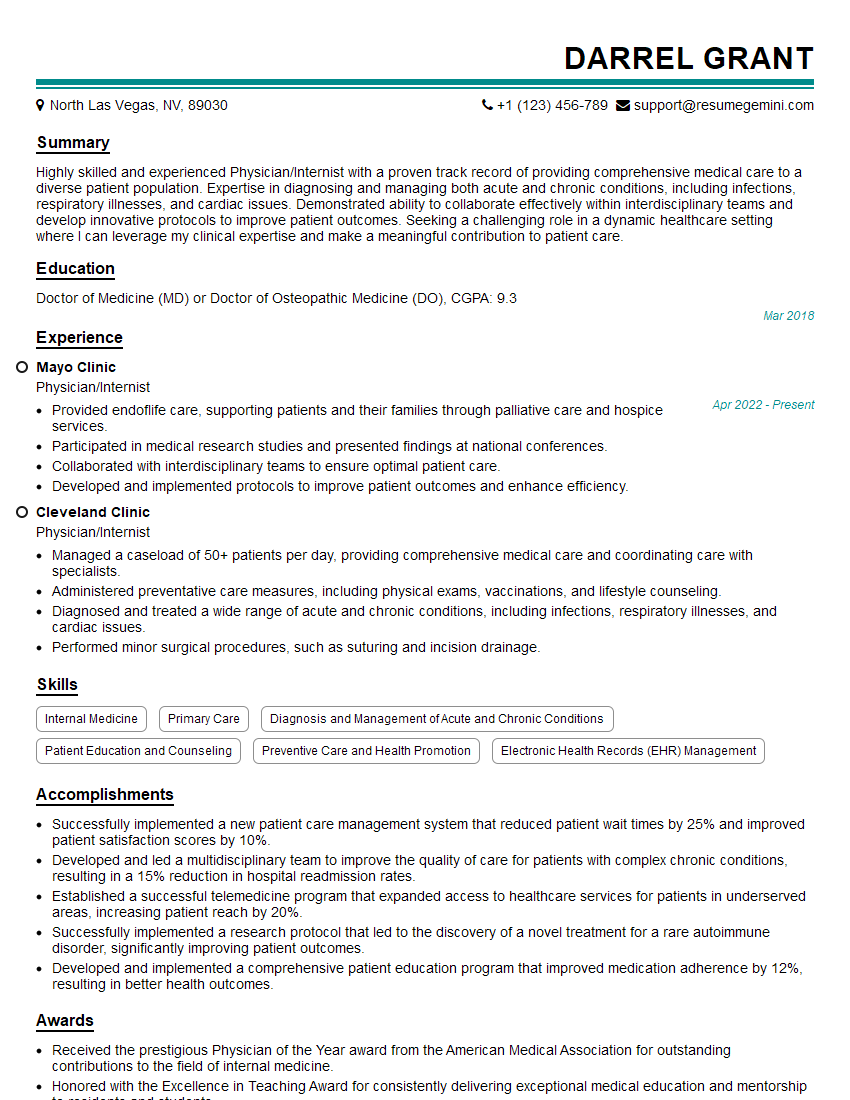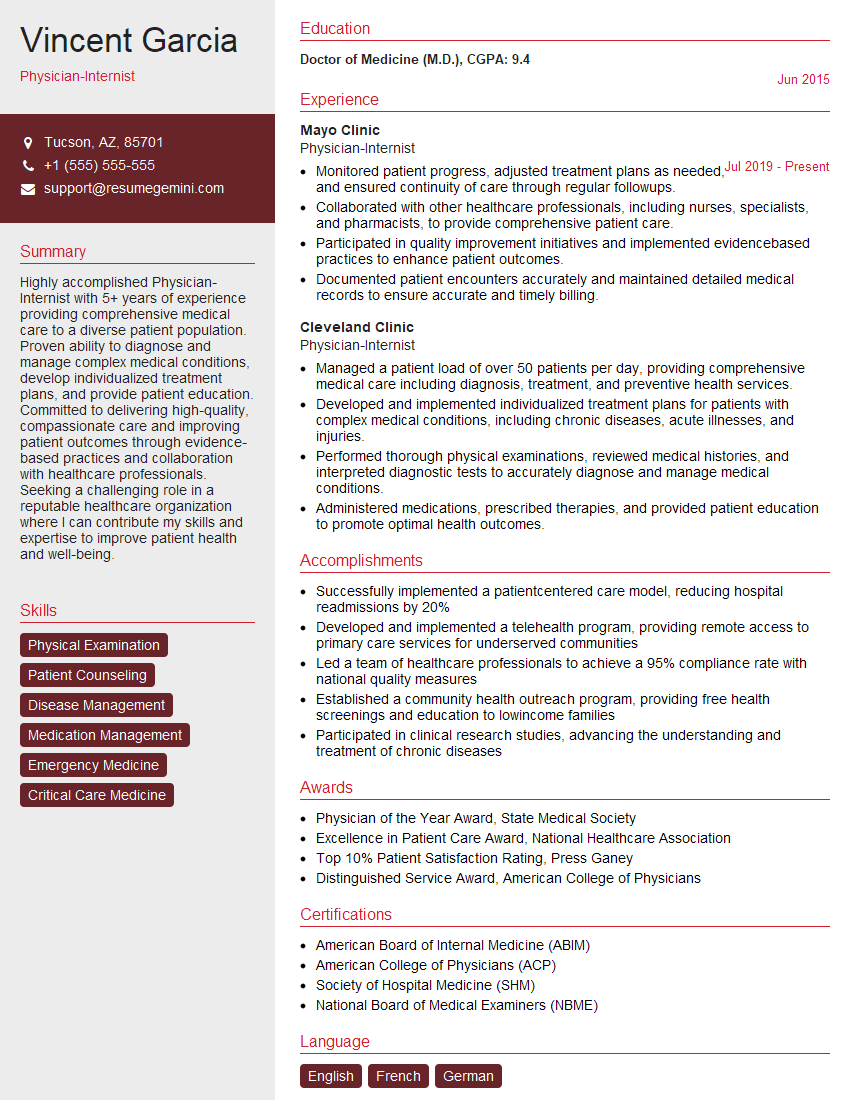Feeling lost in a sea of interview questions? Landed that dream interview for Physician/Internist but worried you might not have the answers? You’re not alone! This blog is your guide for interview success. We’ll break down the most common Physician/Internist interview questions, providing insightful answers and tips to leave a lasting impression. Plus, we’ll delve into the key responsibilities of this exciting role, so you can walk into your interview feeling confident and prepared.
Acing the interview is crucial, but landing one requires a compelling resume that gets you noticed. Crafting a professional document that highlights your skills and experience is the first step toward interview success. ResumeGemini can help you build a standout resume that gets you called in for that dream job.
Essential Interview Questions For Physician/Internist
1. Describe your approach to managing a patient with uncontrolled hypertension?
I would first obtain a detailed medical history and perform a physical examination to identify any underlying causes for the uncontrolled hypertension. I would then develop a treatment plan that may include lifestyle modifications, such as dietary changes, weight loss, and exercise, as well as medications.
- Lifestyle modifications: I would recommend a diet rich in fruits, vegetables, and whole grains, and low in sodium and saturated fat. I would also encourage regular exercise and weight loss if necessary.
- Medications: I would prescribe medications to lower blood pressure, such as ACE inhibitors, ARBs, beta-blockers, calcium channel blockers, or diuretics. I would titrate the dosage and monitor the patient’s response closely.
2. How would you evaluate a patient with shortness of breath?
History and Physical Examination
- Onset, duration, and severity of symptoms
- Associated symptoms (e.g., cough, chest pain, wheezing)
- Medical history (e.g., asthma, COPD, heart disease)
- Physical examination: auscultation of the chest, inspection of the neck for jugular venous distension or tracheal deviation
Diagnostic Tests
- Chest X-ray: to rule out pneumonia, heart failure, or other structural abnormalities
- Spirometry: to assess lung function and identify obstructive or restrictive lung diseases
- Arterial blood gas: to evaluate oxygen and carbon dioxide levels
- Echocardiogram: to evaluate heart function and rule out valvular disease or cardiomyopathy
3. What is your approach to managing a patient with diabetes mellitus type 2?
I would first assess the patient’s overall health and medical history. I would then develop a treatment plan that focuses on lifestyle modifications, such as diet and exercise, as well as medications.
- Lifestyle modifications: I would recommend a diet that is low in carbohydrates and high in fiber. I would also encourage regular exercise, at least 30 minutes most days of the week.
- Medications: I would prescribe medications to lower blood sugar levels, such as metformin, sulfonylureas, or insulin. I would titrate the dosage and monitor the patient’s response closely.
4. How would you manage a patient with acute pancreatitis?
I would first assess the patient’s overall health and medical history. I would then provide supportive care, such as fluid resuscitation, pain management, and antibiotics. I would also monitor the patient’s vital signs and laboratory tests closely.
- Supportive care: I would administer intravenous fluids to prevent dehydration and electrolyte imbalances. I would also prescribe pain medication to relieve pain.
- Antibiotics: I would prescribe antibiotics to prevent or treat infection, if necessary.
- Monitoring: I would monitor the patient’s vital signs and laboratory tests closely to assess their response to treatment and identify any complications.
5. What are the key principles of rational antibiotic prescribing?
- Choose the narrowest spectrum antibiotic that is effective against the most likely pathogen.
- Use the shortest course of antibiotics possible.
- Consider the patient’s allergies and comorbidities.
- Monitor the patient’s response to antibiotics and adjust the treatment plan as needed.
6. What is your approach to managing a patient with chronic kidney disease?
I would first assess the patient’s overall health and medical history. I would then develop a treatment plan that focuses on slowing the progression of the disease and preventing complications.
- Lifestyle modifications: I would recommend a diet that is low in sodium and protein. I would also encourage regular exercise and weight loss if necessary.
- Medications: I would prescribe medications to lower blood pressure, such as ACE inhibitors or ARBs. I would also prescribe medications to manage anemia, such as erythropoietin.
7. What are the common causes of unexplained weight loss in adults?
- Gastrointestinal disorders (e.g., celiac disease, Crohn’s disease)
- Endocrine disorders (e.g., hyperthyroidism, diabetes mellitus)
- Cancer
- Chronic infections (e.g., tuberculosis, HIV)
- Medications (e.g., chemotherapy, antidepressants)
8. What is the differential diagnosis for a patient with a fever of unknown origin?
- Infections: bacterial, viral, parasitic, fungal
- Inflammatory disorders: autoimmune diseases, vasculitis
- Malignancies: lymphoma, leukemia
- Miscellaneous: drug reactions, factitious disorder
9. What is your approach to managing a patient with acute asthma exacerbation?
I would first assess the patient’s overall health and medical history. I would then provide supportive care, such as oxygen therapy and inhaled bronchodilators. I would also monitor the patient’s vital signs and laboratory tests closely.
- Supportive care: I would administer oxygen to maintain oxygen saturation levels above 90%. I would also prescribe inhaled bronchodilators, such as albuterol, to relieve bronchospasm.
- Monitoring: I would monitor the patient’s vital signs and laboratory tests closely to assess their response to treatment and identify any complications.
10. What is your approach to managing a patient with chronic obstructive pulmonary disease (COPD)?
I would first assess the patient’s overall health and medical history. I would then develop a treatment plan that focuses on slowing the progression of the disease and preventing complications.
- Lifestyle modifications: I would recommend smoking cessation and regular exercise. I would also provide education on COPD management and self-care.
- Medications: I would prescribe medications to relieve bronchospasm and reduce inflammation, such as inhaled bronchodilators and inhaled corticosteroids.
Interviewers often ask about specific skills and experiences. With ResumeGemini‘s customizable templates, you can tailor your resume to showcase the skills most relevant to the position, making a powerful first impression. Also check out Resume Template specially tailored for Physician/Internist.
Career Expert Tips:
- Ace those interviews! Prepare effectively by reviewing the Top 50 Most Common Interview Questions on ResumeGemini.
- Navigate your job search with confidence! Explore a wide range of Career Tips on ResumeGemini. Learn about common challenges and recommendations to overcome them.
- Craft the perfect resume! Master the Art of Resume Writing with ResumeGemini’s guide. Showcase your unique qualifications and achievements effectively.
- Great Savings With New Year Deals and Discounts! In 2025, boost your job search and build your dream resume with ResumeGemini’s ATS optimized templates.
Researching the company and tailoring your answers is essential. Once you have a clear understanding of the Physician/Internist‘s requirements, you can use ResumeGemini to adjust your resume to perfectly match the job description.
Key Job Responsibilities
Physicians/Internists are responsible for providing comprehensive medical care to adult patients in a variety of settings, including hospitals, clinics, and private practices. Their key responsibilities encompass:
1. Patient Care
Providing comprehensive medical examinations and assessments, including history taking, physical examinations, and laboratory testing.
- Developing and implementing treatment plans, including medication prescriptions, lifestyle modifications, and referrals to specialists.
- Monitoring patient progress and adjusting treatment plans as needed.
2. Diagnosis and Treatment
Diagnosing and treating a wide range of acute and chronic illnesses, such as infections, respiratory conditions, gastrointestinal disorders, and cardiovascular diseases.
- Performing diagnostic procedures, including blood tests, X-rays, and ultrasounds.
- Prescribing and administering medications.
3. Communication and Collaboration
Communicating effectively with patients, families, and other healthcare professionals.
- Providing clear explanations of diagnoses and treatment plans.
- Collaborating with specialists, nurses, and other healthcare providers to ensure coordinated care.
4. Medical Decision-Making
Making informed medical decisions based on the evaluation of patient history, physical examination, and diagnostic test results.
- Weighing the benefits and risks of different treatment options.
- Considering the patient’s preferences and values.
5. Continuing Education
Staying up-to-date on medical advancements and best practices through continuing medical education credits.
- Attending conferences and workshops.
- Reading medical journals and research articles.
Interview Tips
Preparing for a Physician/Internist interview requires thorough research, practice, and confidence. Here are some tips to help you ace the interview:
1. Research the Organization and Position
Familiarize yourself with the hospital or clinic’s history, mission, values, and services. Understand the specific role of the Physician/Internist within the organization’s healthcare team.
- Visit the organization’s website and read any available materials.
- Research the interviewing team, including the hiring manager and any other interviewers.
2. Practice Answering Common Interview Questions
Prepare your responses to common interview questions, focusing on highlighting your qualifications, experience, and skills. Use the STAR method to structure your answers: Situation, Task, Action, Result.
- Describe a time you successfully diagnosed and treated a complex patient case.
- Share an example of how you effectively communicated with a patient or family.
3. Prepare Questions to Ask the Interviewers
Asking thoughtful questions demonstrates your interest and engagement in the position. Prepare specific questions about the hospital, the team, the patient population, and the organization’s culture.
- What are the biggest challenges and opportunities facing the department?
- What is the organization’s commitment to diversity and inclusion?
4. Dress Professionally and Arrive Punctually
First impressions matter. Dress appropriately in business attire and arrive at the interview on time. Bring a portfolio or folder with your resume, references, and any other relevant materials.
- Make eye contact, smile, and greet the interviewers with a firm handshake.
- Be respectful of the interviewers’ time and conclude the interview promptly.
5. Follow Up After the Interview
Within 24 hours of the interview, send a thank-you note to the interviewers. Express your appreciation for their time and reiterate your interest in the position. You can also use the opportunity to clarify any points or provide additional information that may have been left out during the interview.
Next Step:
Now that you’re armed with interview-winning answers and a deeper understanding of the Physician/Internist role, it’s time to take action! Does your resume accurately reflect your skills and experience for this position? If not, head over to ResumeGemini. Here, you’ll find all the tools and tips to craft a resume that gets noticed. Don’t let a weak resume hold you back from landing your dream job. Polish your resume, hit the “Build Your Resume” button, and watch your career take off! Remember, preparation is key, and ResumeGemini is your partner in interview success.

